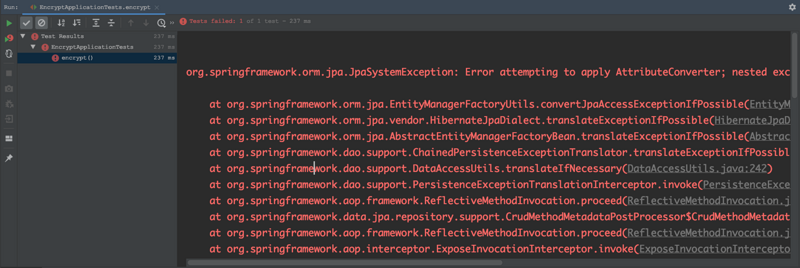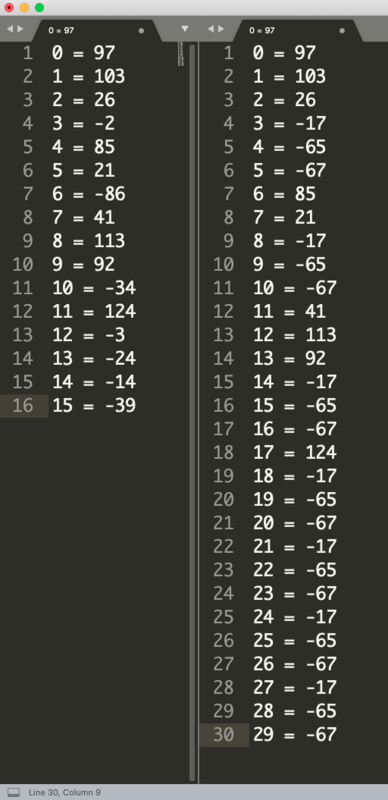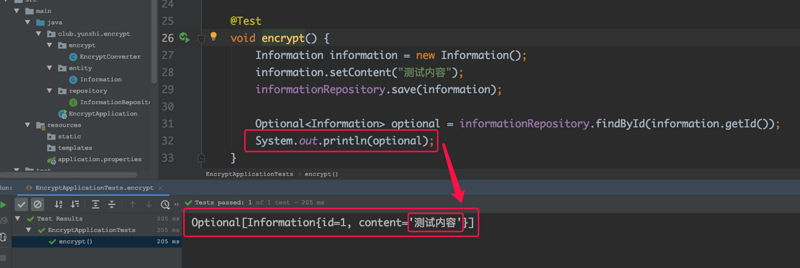JPA AES 引发的 String 二进制数据 DATA LOSS 问题
引言
系统要求高安全性,试题的数据需要加密,防止在数据库层面进行数据泄漏。
但试题的加密还与密码的加密不同,用户密码的加密可以使用 Hash 算法,无法解密,不光在数据库中,即便是我们的程序也无法获悉用户的密码。
试题的加密要求数据库层面是加密数据,从数据库中查询数据后,再对数据进行解密,发送给前台。接口是经过精密的认证与鉴权的,保证安全。
最终对比各种方案,决定采用 converter 的实现方案。
实现
图解

如上图所示:当数据写入前,对数据进行加密;数据查询后,对数据进行解密。
所有的加密解密工作,均由自定义 converter 完成。
错误示例
照着 Demo 写了一个使用 AES 加解密的 converter 。
/**
* 加密解决转换器
* 对象字段数据 与 数据表列之间转换
*/
public class EncryptConverter implements AttributeConverter<String, String> {
private static final Logger logger = LoggerFactory.getLogger(EncryptConverter.class);
/**
* AES 密钥
*/
private static final byte[] VALUE = "XQRhrQnGNFJf1WaSGOOJEjNhDjRPMG5N".getBytes(StandardCharsets.UTF_8);
/**
* 加密/解密 算法
*/
private static final String ALGORITHM = "AES";
/**
* 加密/解密 密钥
*/
private static final Key KEY = new SecretKeySpec(VALUE, ALGORITHM);
/**
* 加密过程
* 从对象字段数据 到 数据库列
*/
@Override
public String convertToDatabaseColumn(String data) {
String result;
try {
logger.debug("获取算法");
Cipher cipher = Cipher.getInstance(ALGORITHM);
logger.debug("设置加密模式与加密密钥");
cipher.init(Cipher.ENCRYPT_MODE, KEY);
logger.debug("获取原始内容");
byte[] rawData = data.getBytes(StandardCharsets.UTF_8);
logger.debug("加密");
byte[] encryptedData = cipher.doFinal(rawData);
logger.debug("加密后的字节数组编码为字符串");
result = new String(encryptedData);
} catch (IllegalBlockSizeException | BadPaddingException | NoSuchPaddingException | NoSuchAlgorithmException | InvalidKeyException e) {
throw new RuntimeException("encrypt error!", e);
}
return result;
}
@Override
public String convertToEntityAttribute(String data) {
String result;
try {
logger.debug("获取算法");
Cipher cipher = Cipher.getInstance(ALGORITHM);
logger.debug("设置解密模式与解密密钥");
cipher.init(Cipher.DECRYPT_MODE, KEY);
logger.debug("获取加密字节数组");
byte[] encryptedData = data.getBytes(StandardCharsets.UTF_8);
logger.debug("解密为原始内容");
byte[] rawData = cipher.doFinal(encryptedData);
logger.debug("解密");
result = new String(rawData);
} catch (IllegalBlockSizeException | BadPaddingException | NoSuchPaddingException | NoSuchAlgorithmException | InvalidKeyException e) {
throw new RuntimeException("decrypt error!", e);
}
return result;
}
}
再对要加密的字段添加 @Convert 注解,指明 converter 为之前编写的 EncryptConverter.class 。
@Entity
public class Information {
@Id
@GeneratedValue(strategy = GenerationType.IDENTITY)
private Long id;
@Convert(converter = EncryptConverter.class)
private String content;
}
跑一个单元测试看看是否生效。
@Test
void encrypt() {
Information information = new Information();
information.setContent("测试内容");
informationRepository.save(information);
Optional<Information> optional = informationRepository.findById(information.getId());
System.out.println(optional);
}
出错了,突然发现事情并不简单。

因为异常处理得比较好,定位错误十分迅速:
// JPA异常:使用AttributeConverter时发生错误。 org.springframework.orm.jpa.JpaSystemException: Error attempting to apply AttributeConverter; nested exception is javax.persistence.PersistenceException: Error attempting to apply AttributeConverter. // 由这个错误引起:持久化错误:使用AttributeConverter时发生错误。 Caused by: javax.persistence.PersistenceException: Error attempting to apply AttributeConverter. // 由这个错误引起:运行错误:加密错误! Caused by: java.lang.RuntimeException: decrypt error! // 由这个错误引起:非法的块大小异常,当解密时输入长度必须是16的倍数。 Caused by: javax.crypto.IllegalBlockSizeException: Input length must be multiple of 16 when decrypting with padded cipher.
同时,加密后的数据也有问题:
ag�U�)q/�|����
调试
经过调试与错误排查,发现问题出在字节数组与字符串的转换上。
logger.debug("加密");
byte[] encryptedData = cipher.doFinal(rawData);
logger.debug("加密后的字节数组编码为字符串");
result = new String(encryptedData);
通读 String 类源码,解决该问题。
在 String 类内部实现中,字符串与字节数组之间的转换,是通过编码与解码实现的。
getBytes 方法,将字符串转换为字节数组,即字符到二进制的编码。
public byte[] getBytes(Charset charset) {
if (charset == null) throw new NullPointerException();
return StringCoding.encode(charset, value, 0, value.length);
}
String 类默认采用 UTF-8 编码,编码时调用 UTF_8 类内部的 encode 方法,将字符数组编码为字节数组。
encode 源码,建议阅读。
public int encode(char[] sa, int sp, int len, byte[] da) {
int sl = sp + len;
int dp = 0;
int dlASCII = dp + Math.min(len, da.length);
// ASCII only optimized loop
while (dp < dlASCII && sa[sp] < '/u0080')
da[dp++] = (byte) sa[sp++];
while (sp < sl) {
char c = sa[sp++];
if (c < 0x80) {
// Have at most seven bits
da[dp++] = (byte)c;
} else if (c < 0x800) {
// 2 bytes, 11 bits
da[dp++] = (byte)(0xc0 | (c >> 6));
da[dp++] = (byte)(0x80 | (c & 0x3f));
} else if (Character.isSurrogate(c)) {
if (sgp == null)
sgp = new Surrogate.Parser();
int uc = sgp.parse(c, sa, sp - 1, sl);
if (uc < 0) {
if (malformedInputAction() != CodingErrorAction.REPLACE)
return -1;
da[dp++] = repl;
} else {
da[dp++] = (byte)(0xf0 | ((uc >> 18)));
da[dp++] = (byte)(0x80 | ((uc >> 12) & 0x3f));
da[dp++] = (byte)(0x80 | ((uc >> 6) & 0x3f));
da[dp++] = (byte)(0x80 | (uc & 0x3f));
sp++; // 2 chars
}
} else {
// 3 bytes, 16 bits
da[dp++] = (byte)(0xe0 | ((c >> 12)));
da[dp++] = (byte)(0x80 | ((c >> 6) & 0x3f));
da[dp++] = (byte)(0x80 | (c & 0x3f));
}
}
return dp;
}
String 类中的 bytes 构造函数,将字节数组转换为字符串,即二进制到字符的解码。
public String(byte bytes[]) {
this(bytes, 0, bytes.length);
}
与编码类似,解码时调用 UTF_8 类内部的 decode 方法,将字节数组解码为字符数组。
decode 源码,建议阅读。
public int decode(byte[] sa, int sp, int len, char[] da) {
final int sl = sp + len;
int dp = 0;
int dlASCII = Math.min(len, da.length);
ByteBuffer bb = null; // only necessary if malformed
// ASCII only optimized loop
while (dp < dlASCII && sa[sp] >= 0)
da[dp++] = (char) sa[sp++];
while (sp < sl) {
int b1 = sa[sp++];
if (b1 >= 0) {
// 1 byte, 7 bits: 0xxxxxxx
da[dp++] = (char) b1;
} else if ((b1 >> 5) == -2 && (b1 & 0x1e) != 0) {
// 2 bytes, 11 bits: 110xxxxx 10xxxxxx
if (sp < sl) {
int b2 = sa[sp++];
if (isNotContinuation(b2)) {
if (malformedInputAction() != CodingErrorAction.REPLACE)
return -1;
da[dp++] = replacement().charAt(0);
sp--; // malformedN(bb, 2) always returns 1
} else {
da[dp++] = (char) (((b1 << 6) ^ b2)^
(((byte) 0xC0 << 6) ^
((byte) 0x80 << 0)));
}
continue;
}
if (malformedInputAction() != CodingErrorAction.REPLACE)
return -1;
da[dp++] = replacement().charAt(0);
return dp;
} else if ((b1 >> 4) == -2) {
// 3 bytes, 16 bits: 1110xxxx 10xxxxxx 10xxxxxx
if (sp + 1 < sl) {
int b2 = sa[sp++];
int b3 = sa[sp++];
if (isMalformed3(b1, b2, b3)) {
if (malformedInputAction() != CodingErrorAction.REPLACE)
return -1;
da[dp++] = replacement().charAt(0);
sp -= 3;
bb = getByteBuffer(bb, sa, sp);
sp += malformedN(bb, 3).length();
} else {
char c = (char)((b1 << 12) ^
(b2 << 6) ^
(b3 ^
(((byte) 0xE0 << 12) ^
((byte) 0x80 << 6) ^
((byte) 0x80 << 0))));
if (Character.isSurrogate(c)) {
if (malformedInputAction() != CodingErrorAction.REPLACE)
return -1;
da[dp++] = replacement().charAt(0);
} else {
da[dp++] = c;
}
}
continue;
}
if (malformedInputAction() != CodingErrorAction.REPLACE)
return -1;
if (sp < sl && isMalformed3_2(b1, sa[sp])) {
da[dp++] = replacement().charAt(0);
continue;
}
da[dp++] = replacement().charAt(0);
return dp;
} else if ((b1 >> 3) == -2) {
// 4 bytes, 21 bits: 11110xxx 10xxxxxx 10xxxxxx 10xxxxxx
if (sp + 2 < sl) {
int b2 = sa[sp++];
int b3 = sa[sp++];
int b4 = sa[sp++];
int uc = ((b1 << 18) ^
(b2 << 12) ^
(b3 << 6) ^
(b4 ^
(((byte) 0xF0 << 18) ^
((byte) 0x80 << 12) ^
((byte) 0x80 << 6) ^
((byte) 0x80 << 0))));
if (isMalformed4(b2, b3, b4) ||
// shortest form check
!Character.isSupplementaryCodePoint(uc)) {
if (malformedInputAction() != CodingErrorAction.REPLACE)
return -1;
da[dp++] = replacement().charAt(0);
sp -= 4;
bb = getByteBuffer(bb, sa, sp);
sp += malformedN(bb, 4).length();
} else {
da[dp++] = Character.highSurrogate(uc);
da[dp++] = Character.lowSurrogate(uc);
}
continue;
}
if (malformedInputAction() != CodingErrorAction.REPLACE)
return -1;
b1 &= 0xff;
if (b1 > 0xf4 ||
sp < sl && isMalformed4_2(b1, sa[sp] & 0xff)) {
da[dp++] = replacement().charAt(0);
continue;
}
sp++;
if (sp < sl && isMalformed4_3(sa[sp])) {
da[dp++] = replacement().charAt(0);
continue;
}
da[dp++] = replacement().charAt(0);
return dp;
} else {
if (malformedInputAction() != CodingErrorAction.REPLACE)
return -1;
da[dp++] = replacement().charAt(0);
}
}
return dp;
}
DATA LOSS
如果阅读过源码之后,或者对编码比较熟悉,应该明白问题出在哪里了。
解码过程中可能出现解码错误的情况。

UTF-8 中,一个字符肯定对应着一个编码,但是一个编码,不一定对应着一个字符。
logger.debug("加密");
byte[] encryptedData = cipher.doFinal(rawData);
logger.debug("加密后的字节数组编码为字符串");
result = new String(encryptedData);
所以,加密后的字节数组不符合 UTF-8 编码规则,解码错误。
然后,数据库中加密后的数据就这样了:
ag�U�)q/�|����
解密的时候,查询这个异常的字符串,再调用 getBytes 方法将其编码为字节数组。
因为解码的错误,所以这里的编码结果也不正确,所以解密中获取的字节数组与原加密后的字节数组不同。

如上图所示:左侧为编码时的字节数组各下标内容,右侧为解码时的字节数组各下标内容。
两者不等价,这在 Java 术语中称为 DATA LOSS 。
所以会有这句建议:
String is not a good container for binary data.
解决
将原需要进行编码的 new String(bytes) 修改为对二进制数据无损的方法调用即可。
我这里采用 Base64 方式对字节数组进行编码解码,保证数据无损。
完整代码:
/**
* 加密解决转换器
* 对象字段数据 与 数据表列之间转换
*/
public class EncryptConverter implements AttributeConverter<String, String> {
private static final Logger logger = LoggerFactory.getLogger(EncryptConverter.class);
/**
* AES 密钥
*/
private static final byte[] VALUE = "XQRhrQnGNFJf1WaSGOOJEjNhDjRPMG5N".getBytes(StandardCharsets.UTF_8);
/**
* 加密/解密 算法
*/
private static final String ALGORITHM = "AES";
/**
* 加密/解密 密钥
*/
private static final Key KEY = new SecretKeySpec(VALUE, ALGORITHM);
/**
* 加密过程
* 从对象字段数据 到 数据库列
*/
@Override
public String convertToDatabaseColumn(String data) {
String result;
try {
logger.debug("获取算法");
Cipher cipher = Cipher.getInstance(ALGORITHM);
logger.debug("设置加密模式与加密密钥");
cipher.init(Cipher.ENCRYPT_MODE, KEY);
logger.debug("获取原始内容");
byte[] rawData = data.getBytes(StandardCharsets.UTF_8);
logger.debug("加密");
byte[] encryptedData = cipher.doFinal(rawData);
logger.debug("BASE64 将加密后的字节数组编码为字符串");
result = Base64.getEncoder().encodeToString(encryptedData);
} catch (IllegalBlockSizeException | BadPaddingException | NoSuchPaddingException | NoSuchAlgorithmException | InvalidKeyException e) {
throw new RuntimeException("encrypt error!", e);
}
return result;
}
@Override
public String convertToEntityAttribute(String data) {
String result;
try {
logger.debug("获取算法");
Cipher cipher = Cipher.getInstance(ALGORITHM);
logger.debug("设置解密模式与解密密钥");
cipher.init(Cipher.DECRYPT_MODE, KEY);
logger.debug("BASE64 将编码后的字符串解码为加密字节数组");
byte[] encryptedData = Base64.getDecoder().decode(data);
logger.debug("解密为原始内容");
byte[] rawData = cipher.doFinal(encryptedData);
logger.debug("解密");
result = new String(rawData);
} catch (IllegalBlockSizeException | BadPaddingException | NoSuchPaddingException | NoSuchAlgorithmException | InvalidKeyException e) {
throw new RuntimeException("decrypt error!", e);
}
return result;
}
}
测试
再次运行该单元测试。
@Test
void encrypt() {
Information information = new Information();
information.setContent("测试内容");
informationRepository.save(information);
Optional<Information> optional = informationRepository.findById(information.getId());
System.out.println(optional);
}
数据表中数据完成加密:

数据查询后自动解密:

总结
源码,因为面试而变了味道。
程序,因为资本而变得功利。
你,还记得写代码的初心吗?











![[HBLOG]公众号](http://www.liuhaihua.cn/img/qrcode_gzh.jpg)

